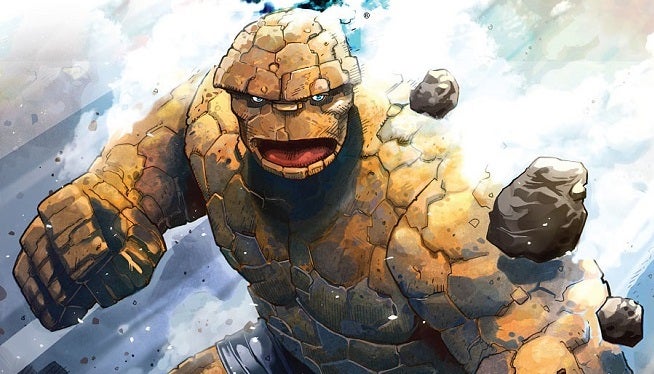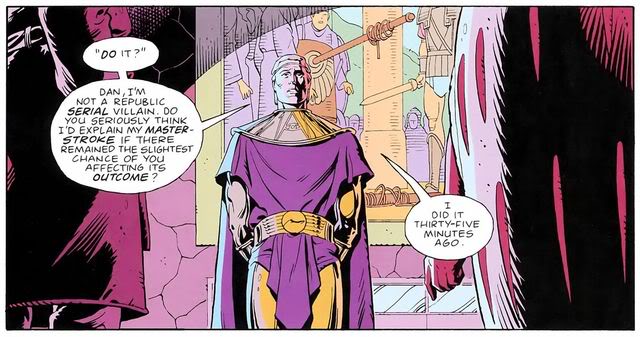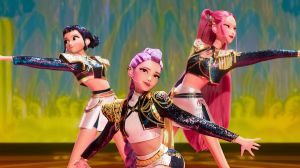I kid though. For these last few issues before Fantastic Four‘s unfortunate (and hopefully temporary) demise, we’re reverting to the series’ original numbering going back all the way to Stan Lee and Jack Kirby’s issue one way back in November 1961. If the FF is about anything, it’s about family first. After that, it tends to be very deeply rooted in its own history and this run has been doing an excellent job of spinning a new superheroic yarn which pays tribute to a great many aspects of the team’s history. This issue continues that effort quite admirably.
Videos by ComicBook.com
Once again, the creative team provides an excellent read which advances the story on all fronts while remaining rooted in the Marvel Universe with wonderful art, action, and character moments. I don’t know that I can recall an arc in this series during my time as a reader (beginning in the dark days of the early ’90s) that I’d recommend quite as highly. There’s an energy and heart to this arc which is quite gratifying as a long-time reader.
As much as I hate the concept of variant covers, I can’t even grouse too much about the covers provided by Michael Golden as well as Jim Cheung and Shawn Yap. Golden’s cover has a great, slightly retro feel depicting the Fantastic Four’s origin. It’s a wonderful piece which through its composition engages the viewer and makes you unsure whether it is best viewed normally or on its side. Cheung and Yap’s piece is similarly superlative. I’ve always loved Cheung’s art and I’m particularly fond of the way he depicts Ben Grimm’s face. I’m quite pleased to see that he was engaged in this commemorative effort as the series winds down to a close. This isn’t to say though that Kirk, Kesel, and Aburtov’s main cover isn’t great. It’s beautifully rendered and does an excellent job of representing and drawing one into the action contained within this installment of the series.
Starting here, I’m probably going to start dropping the occasional SPOILER so proceed with caution…
Continuing along with the art, I don’t have a bad word to say about the art team. Kirk and Kesel are spot-on with characters, locations, expressions, and action. As always Kirk constructs his pages wonderfully with respect to his panel layouts. I really do appreciate the use of structured panels as an entirely free-form style doesn’t allow for the same subversion of the structure. What do I mean by this? Well, during the opening fight scene at the Baxter Building, one page is constructed of five horizontal panels each taking up the full width of the page and stacked one on top of the other. If Kirk had not presented this page in this manner, then Namor would not appear to be flying off of it at the reader. You see, the Sub-Mariner’s body is almost the only thing on the page to overlap the borders as he is sent flying by a punch from Ben “The Thing” Grimm. This is beautifully done, and as I say, gives the impression that he has been punched so hard that he has been liberated from the panel structure and the page itself.
This issue is full of fun, little touches. One favorite that might be easily missed by many readers comes from colorist Aburtov. When Sue “The Invisible Woman” Richards loses her temper, the pupils of her eyes change from blue to “invisible,” taking on the coloring of her trademark force fields. I don’t know that I’ve ever seen this effect done before but I think it fits perfectly and applaud Aburtov for really going the extra mile. Throughout this book, Aburtov is a welcome presence, adding form and structure within Kesel’s crisp inks as well as emphasizing location, mood, and tone. The amount of detail he puts into every face and even such objects as Cap’s shield as it spins through the air is frankly impressive.
Turning back to Kirk, it’s hard to overemphasize just what an excellent job he is doing here. Characters are wonderfully expressive and their anatomy is impeccable. Some lesser artists have difficulty dealing with the human form when in odd poses or presented at off-kilter angles, bodies appearing warped or stiff. Here though, Kirk wonderfully captures Sub-Mariner reeling from a punch, Cap limboing under his own shield sent back toward him, and more engaging figure work. I also applaud his continued ability to make the children of the Future Foundation look like children rather than miniature adults. Really, the combined efforts of Kirk, Kesel, and Aburtov come together to make every page visually engaging and a joy to behold.
Focusing our attention on the writing, Robinson continues to thrill. The rubber is truly meeting the road here as this arc hurtles toward its conclusion and I’m very excited to see how this all shakes out. This may be the arc’s bleakest hour with the Quiet Man’s plan coming to fruition, Reed captured, and the rest of the team with only what seems to be the most general idea of what to do to fix things. Still, there is fun and hope to be had which makes for a truly engaging read.
I mentioned in a previous review that I’m pleased that Robinson is actually making an effort to place this story within the Marvel Universe and make us feel its interconnectedness. All too often these days, it seems as though series occur in hermetically sealed bubbles only interacting in very deliberate ways, often restricted to “events.” Here though, the characters appearing within Robinson’s All-New Invaders pop up, including Jim “The Android Human Torch” Hammond, Namor, and the timely Sam Wilson as Captain America. On top of that though, we bump into the Hulk sporting his current moniker of “Doc Green” and speaking like a civilized human being. This is part of the joy of the Marvel Universe and its great to see it here.
I applaud Robinson for creating a truly formidable and memorable villain in the Quiet Man whose obsession with the team has only made him a more dangerous figure. His deliberate use and manipulation of the FF’s past has also allowed this arc to believably delve into aspects of the team’s history without feeling forced. The more time I spend with him, the more I want to see of him in the future. In a way, he is a blend of several established FF villains. He has the brilliance of Doctor Doom, the methodical planning of the Mad Thinker, an affection for Sue to rival or surpass Namor, and the (here’s an obscure one) the financial/influential pull of Gregory Gideon.
I’ve already praised Robinson enough here and in past reviews for his mining of the Fantastic Four’s past for new drama but I do just want to note that it is a joy to see the Psycho-Man even just in a brief flashback cameo. Also, the very idea of the Franklinverse serving as the main instrument of the FF’s destruction continues to be thrilling to a longtime fan of this series.
All that being said, there are three VERY SPOILER-Y moments in this book which I found to be particularly enjoyable and well done. One is the heroic turn of Bentley 23 who decides that rather than stand by his “father,” the villainous Wingless Wizard, he will save Franklin and the rest of the Future Foundation. All throughout this arc, I’ve been wondering about his apparent embracing of overt villainy and this wonderful bit of heroism clears things up nicely while showing at least some of the potential of the Future Foundation kids.
Another moment was the final page reveal of Sleepwalker, a relatively obscure Marvel hero who will apparently help the Fantastic Four to thwart the Quiet Man’s plans. This is exciting for two reasons. First, any time an obscure character is dusted off and introduced into Fantastic Four, I enjoy the opportunity to learn more about him/her and see how the character bounces off the FF themselves. Second, I don’t recall ever seeing the Franklinverse treated as a “dream” precisely. It always seems to be dealt with from the perspective of an alternate reality. As such, I’m just really interested to see how Sleepwalker’s involvement in this story plays out.
The last moment is less a plot element and more an Easter Egg/reference. A big chunk of this issue consists of the Quiet Man explaining his plan to Reed and unsurprisingly Reed vows to stop him. Now tell me if this sounds familiar, the Quiet Man replies, “I’m not a spy movie villain, divulging my plans to you in detail ahead of time so you can prevent them… The invasion began 49 seconds ago, and nothing can stop it.” If you recognized that line, you’re not alone. It sounds an awful lot like a certain moment from Alan Moore and Dave Gibbons’ Watchmen:
By now, I think it’s pretty obvious how I feel about this issue and this arc as a whole. If you aren’t already reading it, it still isn’t too late to get on board for what promises to be the FF’s last story (within their own book anyway) for a while at least. Kudos to the creative team for their work up to this point and I cannot wait to read the rest. “The End Is Fourever” might sound corny and cryptic, but it reads like a dream so far.










